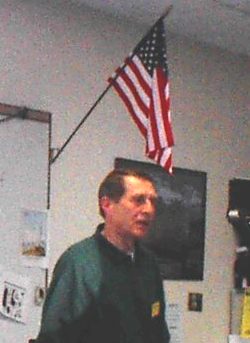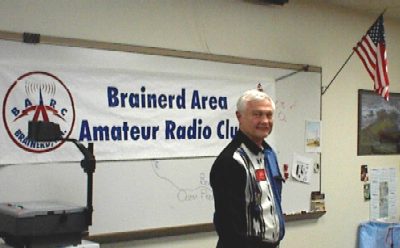
Brainerd Area Amateur Radio Club
March 30, 2000 Meeting

![]()
Brainerd Area Amateur Radio Club
March 30, 2000 Meeting

|
RADIO FREQUENCY DEVICES PRESENTATION BY LYLE KOEHLER, K0LR
Lyle gave an excellent presentation on incidental, intentional, and unintentional radiators of RF energy. They range from commercial transmitters to noise generators like electric motors. In between are garage door opener transmitters and computer systems. Here is a portion of the text of his talk: |
Excerpts from Part 15 of the FCC Rules:
Scope of this Part: This Part sets out the regulations under which an intentional, unintentional, or incidental radiator may be operated without an individual license.
Definitions:
Radio frequency (RF) energy. Electromagnetic energy at any frequency in the radio spectrum between 9 kHz and 3,000,000 MHz.
Incidental radiator. A device that generates radio frequency energy during the course of
its operation although the device is not intentionally designed to generate or emit radio frequency energy. Examples of incidental radiators are dc motors, mechanical light switches, etc.
Intentional radiator. A device that intentionally generates and emits radio frequency
energy by radiation or induction.
Unintentional radiator. A device that intentionally generates radio frequency energy for
use within the device, or that sends radio frequency signals by conduction to associated equipment via connecting wiring, but which is not intended to emit RF energy by radiation or induction.
Carrier current system. A system, or part of a system, that transmits radio frequency
energy by conduction over the electric power lines. A carrier current system can be designed such that the signals are received by conduction directly from connection to the electric power lines (unintentional radiator) or the signals are received over-the-air due to radiation of the radio frequency signals from the electric power lines (intentional radiator).
15.5 General conditions of operation. Operation of an intentional, unintentional, or incidental radiator is subject to the conditions that no harmful interference is caused and that interference must be accepted that may be caused by the operation of an authorized radio station, by another intentional or unintentional radiator, by industrial, scientific and medical (ISM) equipment, or by an incidental radiator.
15.13 Incidental radiators. Manufacturers of these devices shall employ good engineering practices to minimize the risk of harmful interference.
15.23 Home-built devices. (a) Equipment authorization is not required for devices that are not marketed, are not constructed from a kit, and are built in quantities of five or less for personal use. (b) It is recognized that the individual builder of home-built equipment may not possess the means to perform the measurements for determining compliance with the regulations. In this case, the builder is expected to employ good engineering practices to meet the specified technical standards to the greatest extent practicable. The provisions of Section 15.5 apply to this equipment.
Examples of Part 15 Unintentional Radiators:
FREQUENCY BAND, MHz APPLICATION
0.02 - ?? Switching Power Supplies
0.009-0.490 Power Line Carrier Systems
1.0-2.2 AM Radios
98-900 TV and FM Receivers
DC-Daylight Computers
Examples of Part 15 Intentional Radiators
FREQUENCY BAND, MHz APPLICATION
0.160-0.190 LowFER Beacons
0.1-30 Carrier Current Devices
0.510-1.705 Short-Range AM Transmitters
43-50 Cordless Phones, Walkie Talkies
88-108 Micropower FM Transmitters
300-500 Garage Door Openers, Keyless Entry, Security Systems
902-928 Cordless Phones
2400-2438 Cordless Phones, Wireless Video
Converting Field Strength to Transmitter Power:
P = 0.3E2, where P is transmitter power in EIRP (effective isotropic radiated power) in watts and E is the field strength at 3 meters, expressed in volts per meter.
Permitted Radiation in the 9 kHz to 30 MHz Range:
FREQUENCY, (MHz) SPECIFIED LIMIT E.I.R.P
* = guess
0.160-0.190 1 Watt; 15 meter antenna 5 mW *
0.510-1.705 100 mW; 3m antenna 4 mW *
1.705-10.0 100 uV/m @ 30m 0.3 uW
(wideband emissions)
1.705-30 (any) 30 uV/m @ 30m 0.027 uW
13.553-13.567 10,000 uV/m @ 30m 3 mW
26.96-27.28 10,000 uV/m @ 3m 30 uW
Permitted Radiation in the 43 to 50 MHz Range:
10,000 uV/m @ 3m (30 uW) on these frequencies:
43.71-44.49, 46.6-46.98, 48.75-49.51, 49.66-49.82 MHz (Cordless telephones only)
49.82-50.0 MHz (Cordless phones, walkie talkies, etc.)
Permitted Radiation in the 88 to 108 MHz Range:
250 uV/m @ 3m (0.01875 microwatts)
Permitted Radiation in the 285-322 MHz Range (approximate values):
5400 uV/m @ 3m (8.7 microwatts) for intermittent control signals
2200 uV/m @ 3m (1.5 microwatts) for periodic transmissions
Permitted Radiation in the 902-928 and 2400-2483.5 MHz Range:
1 Watt output power for spread spectrum systems
500,000 uV/m @ 3m (75 milliwatts) for field disturbance sensors
50,000 uV/m @ 3m (750 microwatts) for any other devices
Disclaimer: This summary is only a general overview and does not include complete
information about what devices are permitted in certain sub-bands, and about the many frequency ranges where intentional radiation is prohibited. To download a complete copy of the FCC Part 15 rules: go to http://www.fcc.gov/oet/info/rules
Several people expressed interest in the 2.4 GHz wireless video camera I demonstrated at the meeting. Itís called an "XCam2" and is available for $79.99 from http://www.x10.com or by calling 1-800-675-3044.
For more information on LowFER operation in the 160-190 kHz range, visit my web site at http://www.computerpro.com/~lyle
Presentation by: Lyle, K0LR -- e-mail him at: lyle@mlecmn.net
 |
Tod Olson, KØTO from Minneapolis also spoke about his experiences with unintentional RF radiation
sources. He described a wireless cable TV/telephone converter system that can be heard near the 80 meter and 40 meter ham bands.
Tod Olson recently retired as the Dakota Division Director for the American Radio Relay League. He has been a visitor at previous BAARC meetings. |
This page was last updated 12/19/2006